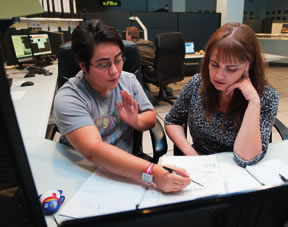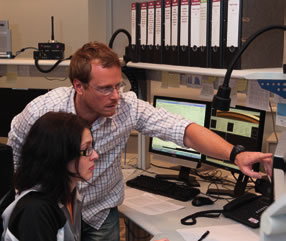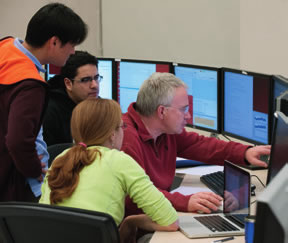Share
Working at ESO
Are you interested in working in areas of frontline technology and in a stimulating international environment? Do you feel your profile matches our requirements? Learn more about our current vacancies and apply online. Read more..








The Atacama Large Millimeter/submillimeter Array (ALMA) is a (sub)millimeter wave interferometer consisting of 66 antennas located on the Llano de Chajnantor in the Atacama Desert of northern Chile, and equipped with receivers covering atmospheric windows between 30 and 950 GHz. ALMA is a partnership of the European Organization for Astronomical Research in the Southern Hemisphere (ESO representing its member states), National Science Foundation (NSF USA) and National Institutes of Natural Sciences (NINS Japan), together with National Research Council (NRC Canada) and National Science Council (NSC) and Academia Sinica Institute of Astronomy and Astrophysics (ASIAA Taiwan), in cooperation with the Republic of Chile. The Joint ALMA Observatory (JAO) is operated by ESO, Associated Universities Inc/National Radio Astronomy Observatory (AUI/NRAO) and the National Astronomical Observatory of Japan (NAOJ).
ALMA System Astronomer
Santiago and OSF, San Pedro de Atacama
Deadline 31/05/2018
The Data Management Group:
The JAO Department of Science Operations (DSO) is responsible for the ALMA observations. It consists of three groups: the Array Operations Group (AOG), the Program Management Group (PMG), which is responsible for scheduling and tracking of projects as well as data quality assurance during the observations, and the Data Management Group (DMG), which is responsible for determining the performance of the array, the development and optimization of the array including the calibration plan as well as pipeline operations and data quality assurance. The DMG consists of the Head and Deputy Head of the group, eight System Astronomers and ten Science Archive Content Managers/pipeline operators. The System Astronomers report directly to the Deputy Head of the Data Management Group.
Duties and responsibilities:
ALMA system astronomers are the experts on the ALMA observatory and its performance, and provide advice and assistance to ALMA operations. They work closely with the ALMA Regional Centers, the system engineers in the ALMA Department of Engineering and the staff in the ALMA Department of Computing. Their duties consist of:
- Monitoring and determining of the long-term performance of the array based on trend analysis.
- Setting requirements and performing tests and evaluations of the on-line software system, including the correlator software.
- Optimizing and developing observing sequence execution.
- Investigating and potentially contributing to corrective action on system level problems discovered in software/hardware.
- Participating in development and commissioning of new capabilities of ALMA.
- Maintenance, development, optimization and execution of the ALMA calibration plan.
- Optimization and development of pipeline software and operations and data quality assurance.
The System Astronomers also contribute to science operations as Astronomers On Duty, and participate in tests and evaluation of the ALMA software systems relevant to operations (pipeline, data quality assurance, scheduling etc.).
The successful candidate is expected and encouraged to conduct his/her own astronomical research. Research in areas directed towards use of ALMA.
Professional requirements/qualifications:
- PhD in Astronomy or Physics.
- At least 3 years of relevant experience after the PhD.
- A strong interest for investigating technical issues, either in software or in hardware.
- Experience in millimeter/sub-mm radio astronomy, either through commissioning or science operations.
- Experience in programming in Python.
- Experience in data reduction of radio astronomical data (using any of the standard packages GILDAS, AIPS, MIRIAD, CASA, etc) will be considered an asset. The successful candidate is expected to master CASA once hired.
- Experience in statistical analysis and programming (using dedicated languages such as R), will be considered an asset.
- Proven track record of scientific research.
- Fluency in the English language (oral and written).
- Proven good interpersonal communication skills and ability to work in a multidisciplinary team, including operators, astronomers and system/software engineers.
Due to travel requirements and work at high altitudes, a successful high altitude medical check is a necessary condition of employment for this position.
Duty Station / Location of Position
Duty stations: Santiago and the Operations Support Facility (OSF) near San Pedro de Atacama, Chile. The successful applicant will be required to do an average of 8 shifts (' 30%) working at the ALMA sites at OSF (2900m elevation) and, on rare occasions, at the Array Operations Site (5000m elevation). (One shift lasts 8 days and is followed by 6 days of rest.)
Contract
Depends on Executive
Remuneration
ALMA International Staff will be recruited as employees of ESO, AUI/NRAO or NAOJ. Each of these employers offer competitive remuneration packages including a competitive salary as well as comprehensive social benefits, and provide financial support in relocating families. Furthermore, if applicable, an expatriation allowance as well as some other allowances will be added.
Application Process
Qualified applicants are invited to apply by submitting an application to one of the ALMA Executives. Applications must be written in English and include:
- Cover Letter addressing the requirements detailed above;
- Curriculum Vitae;
- Research interest statement and list of publications;
- Three reference letters.
Applicants submitting their application to ESO are invited to apply online at http://recruitment.eso.org/. Reference letters should be sent to vacchile@eso.org.
Applicants submitting their application to AUI/NRAO are invited to apply online at http://jobs.jobvite.com/nrao/jobs. Reference letters should be sent to Candice Waller at cwaller@nrao.edu.
Applicants submitting their application to NAOJ are invited to send their application and reference letters to apply-alma-dmg20180531@nao.ac.jp.
The initial deadline for receipt of applications to be considered for the position is 31 May 2018 . However, applications will continue to be accepted until the position is filled.
